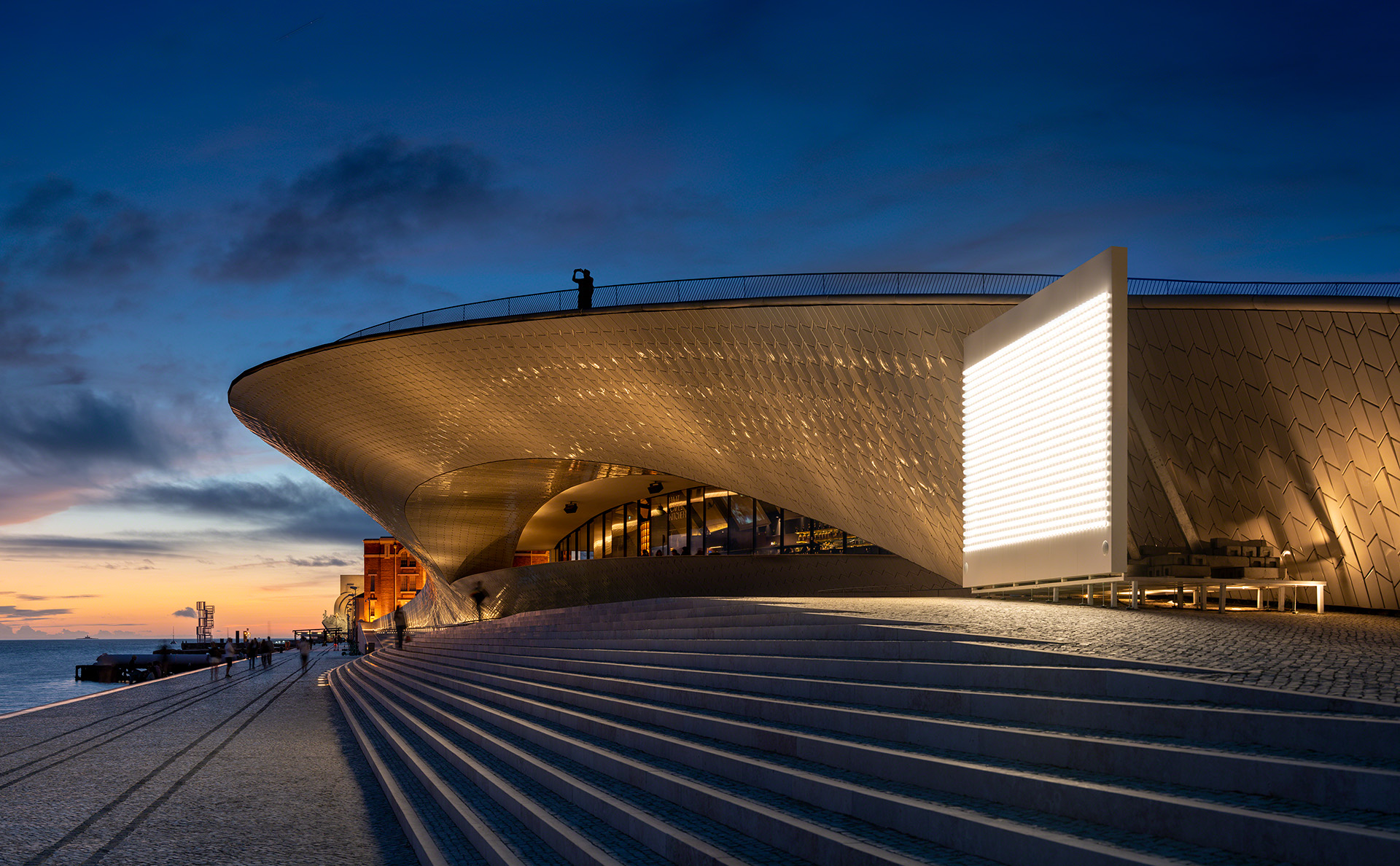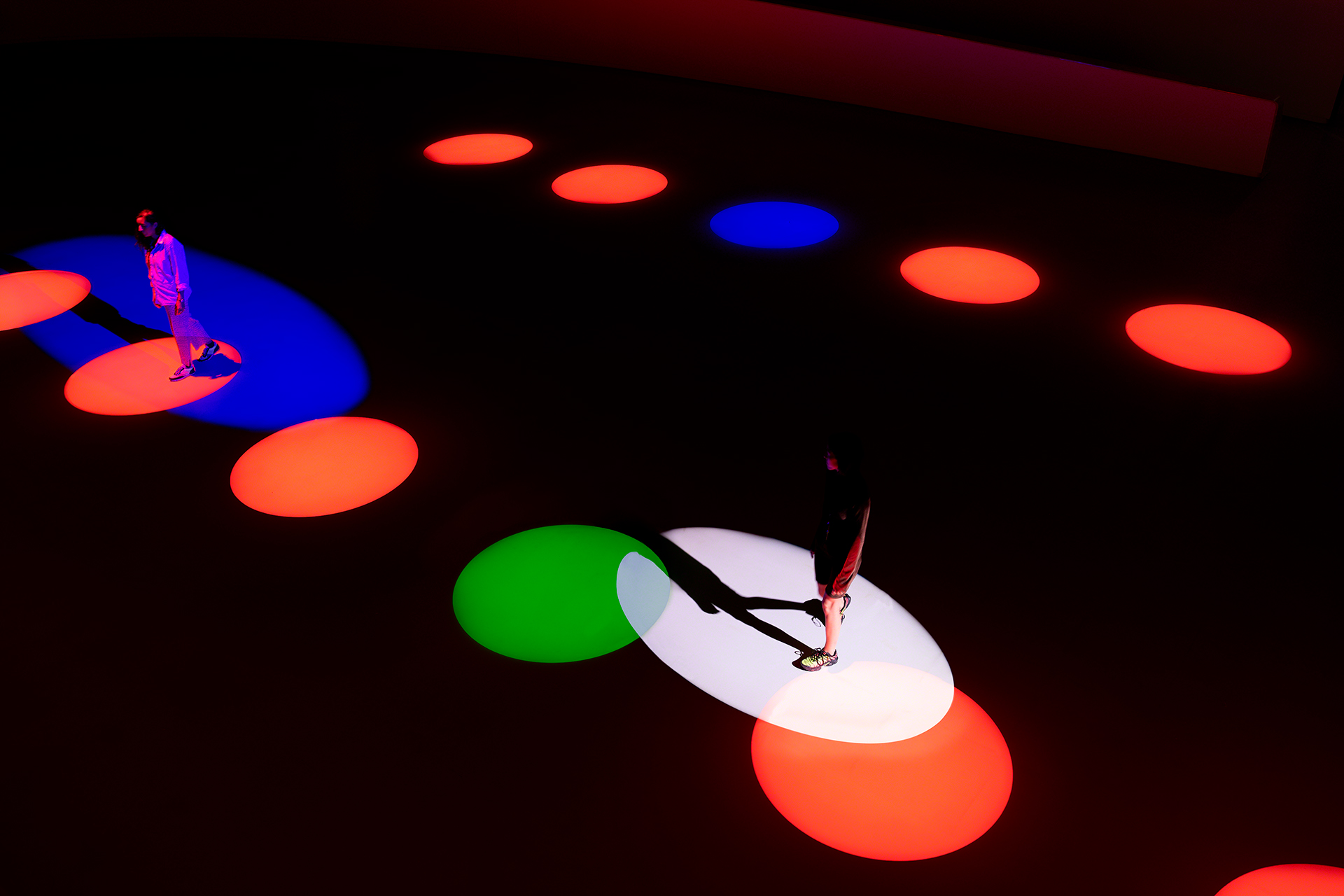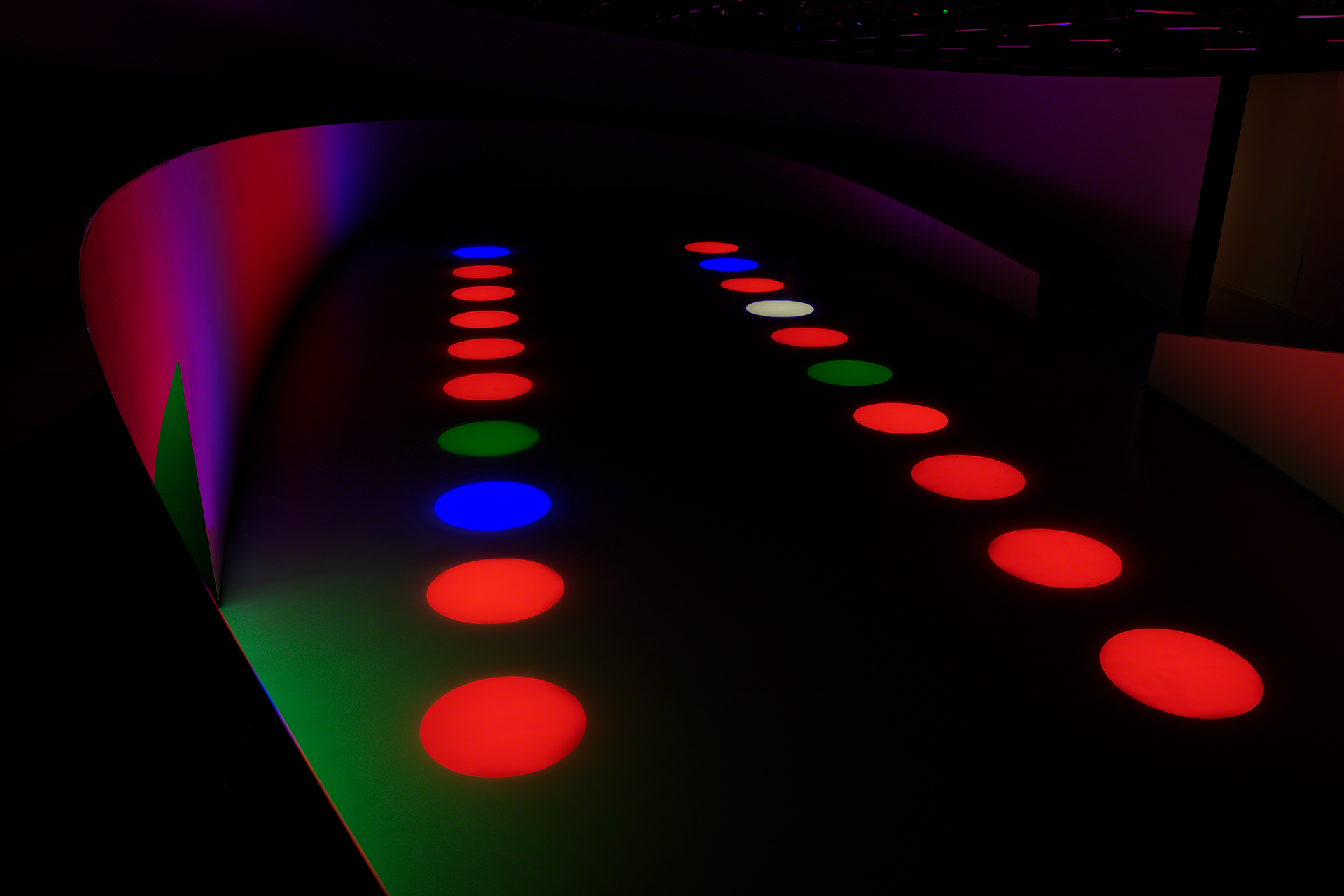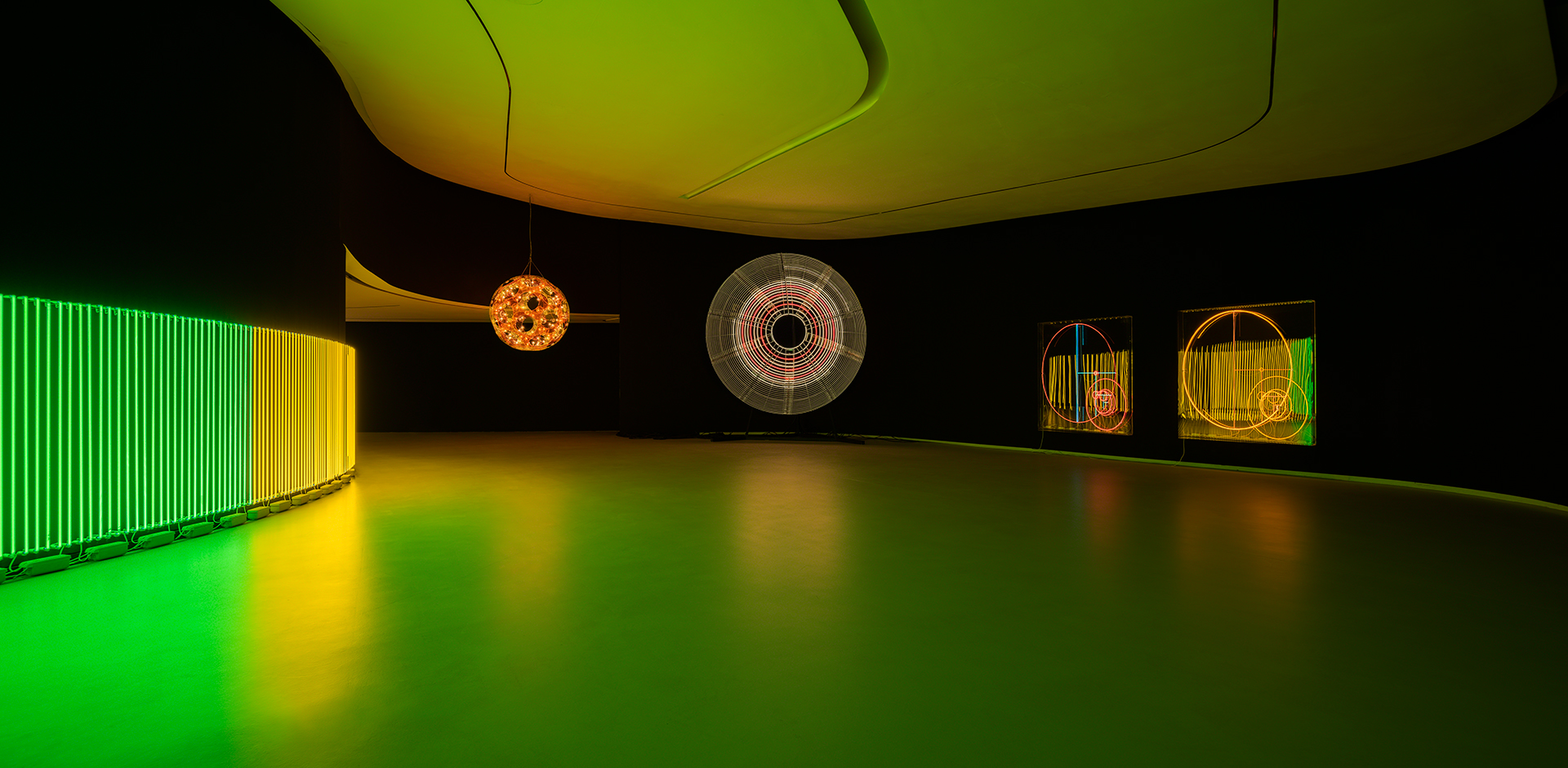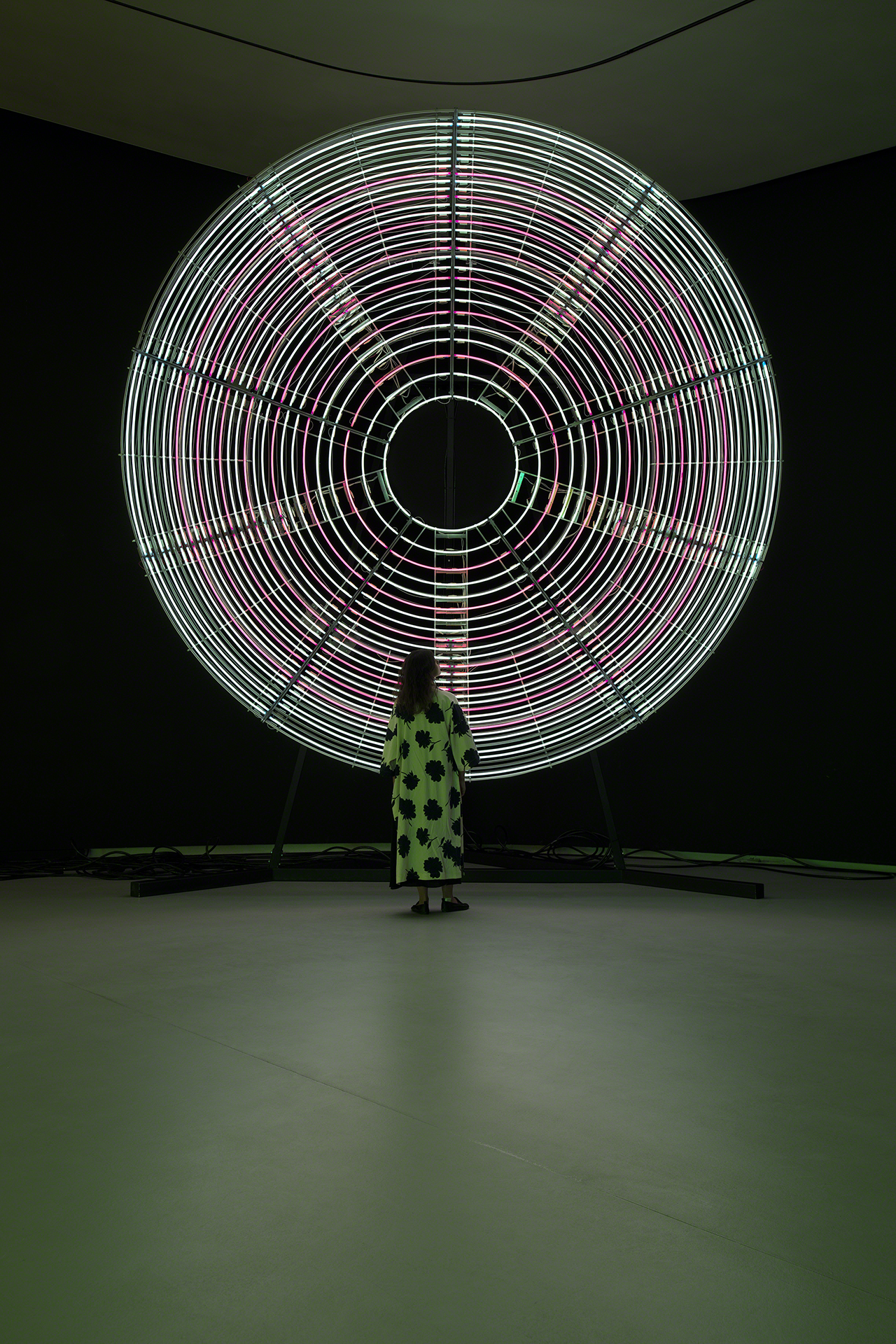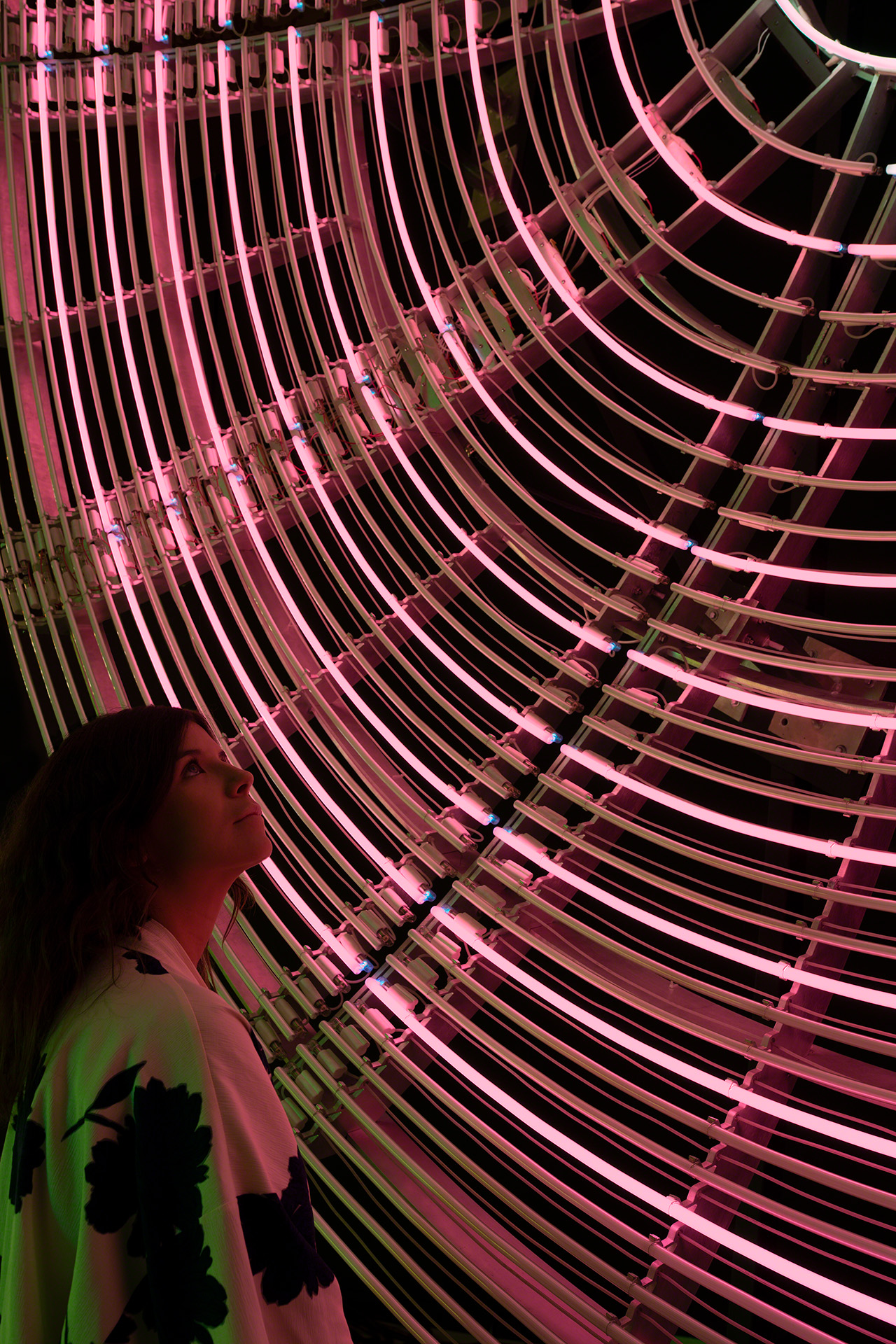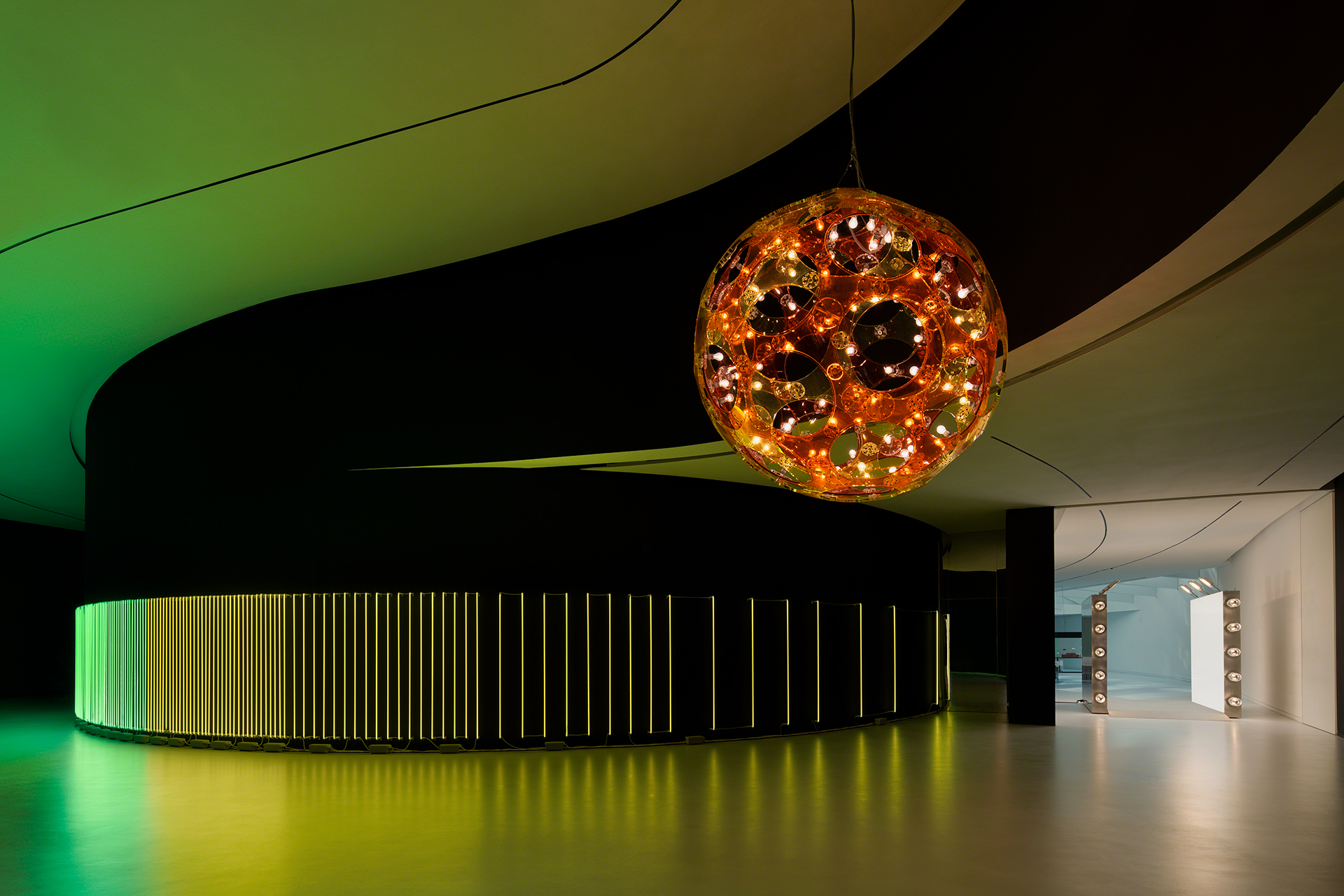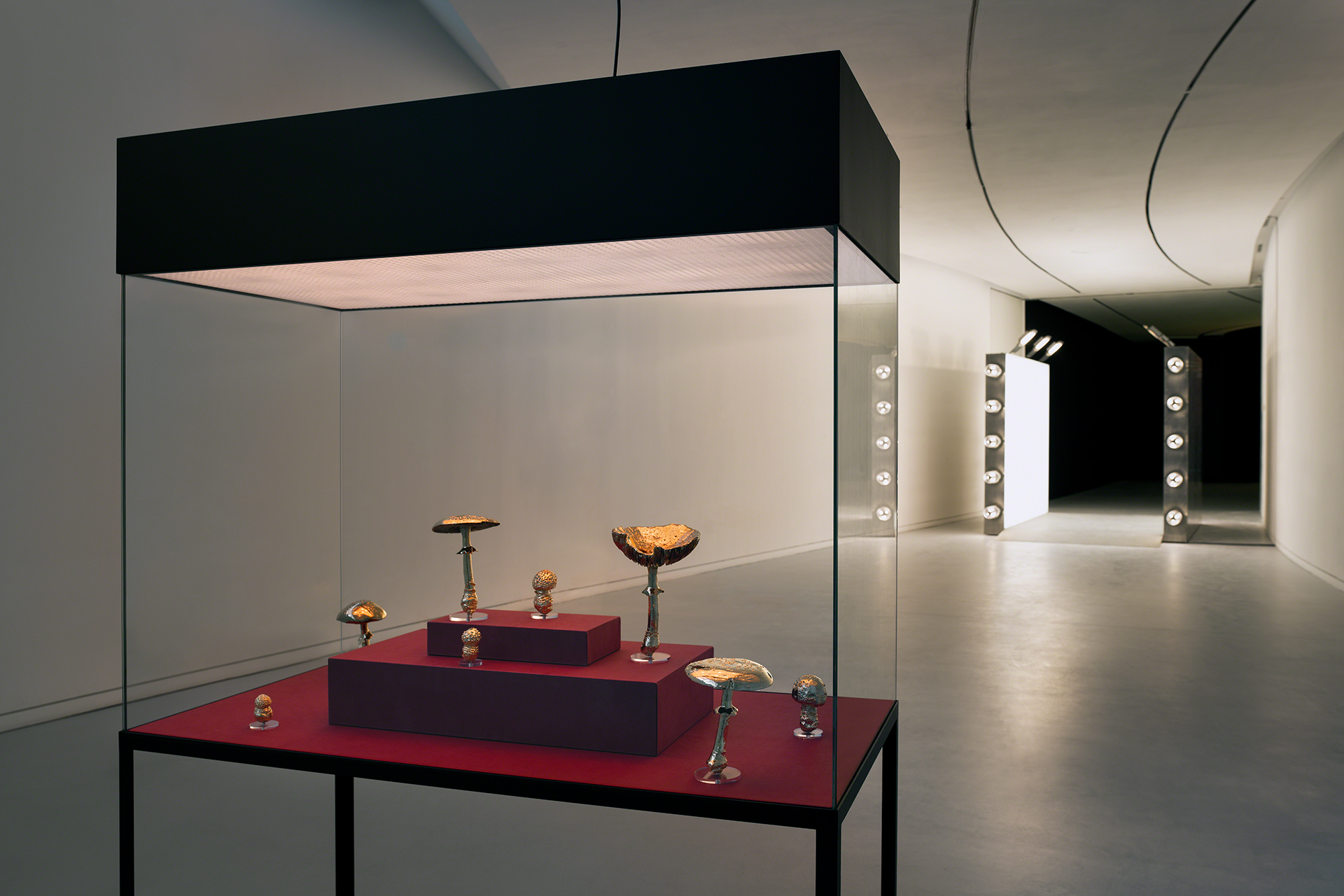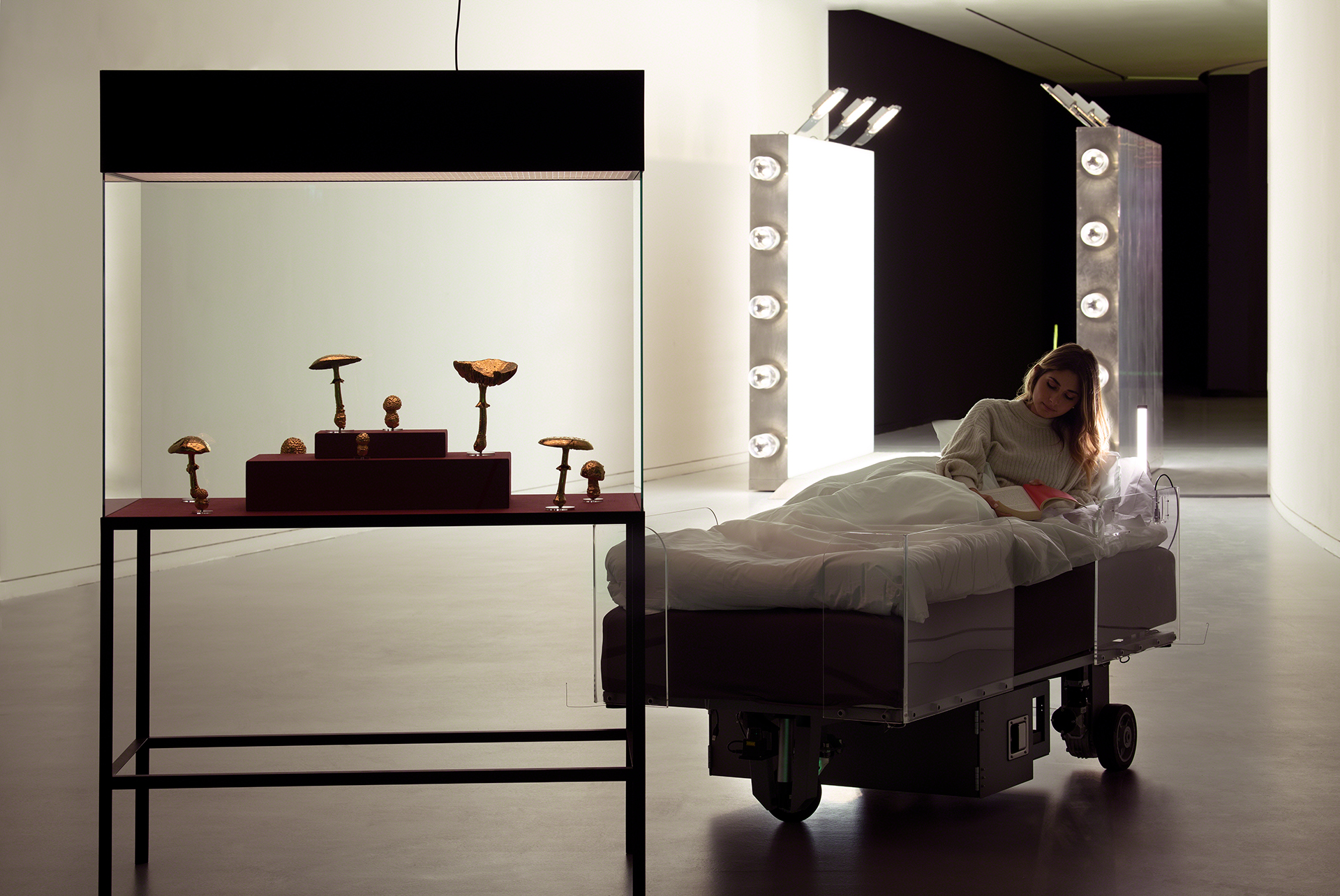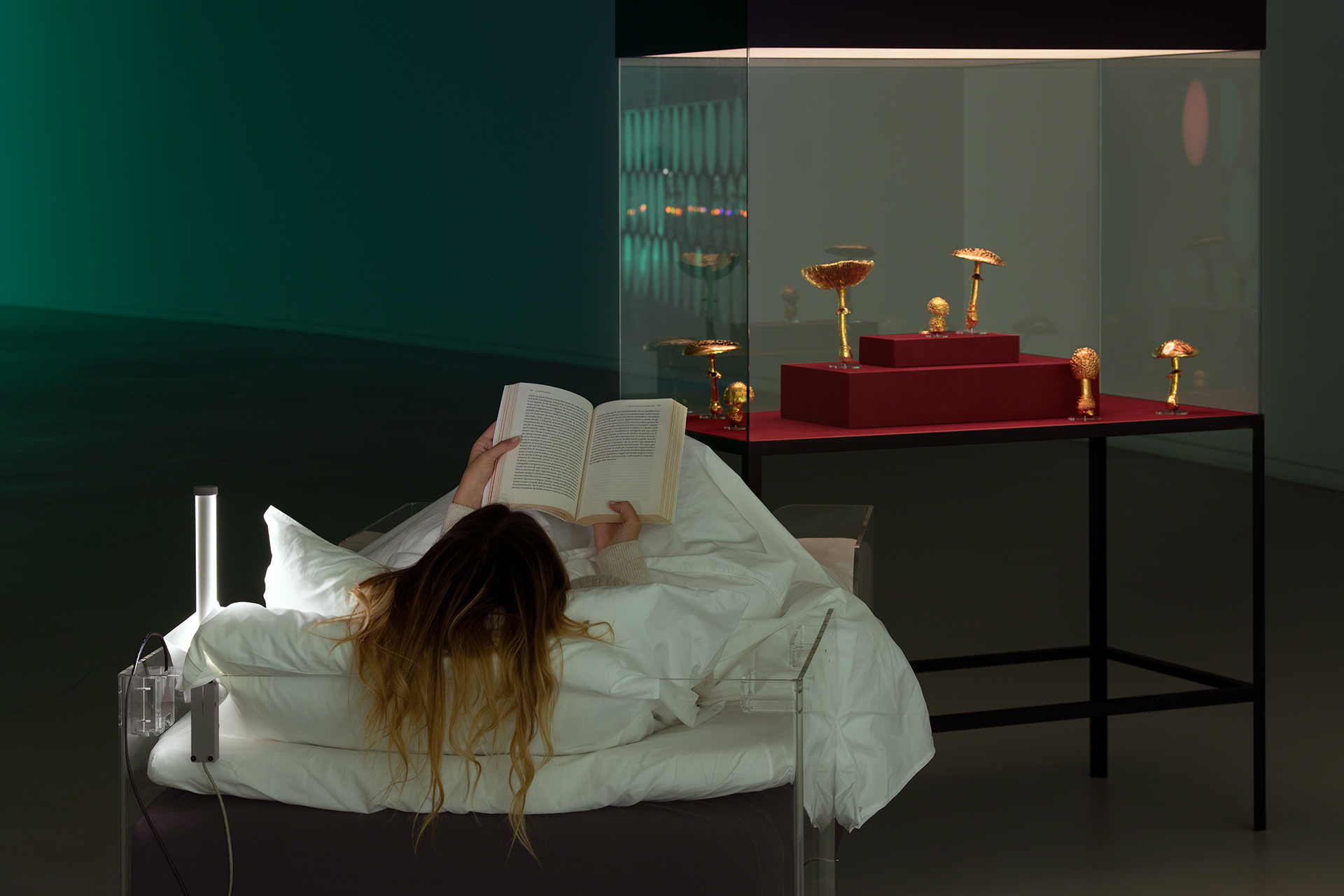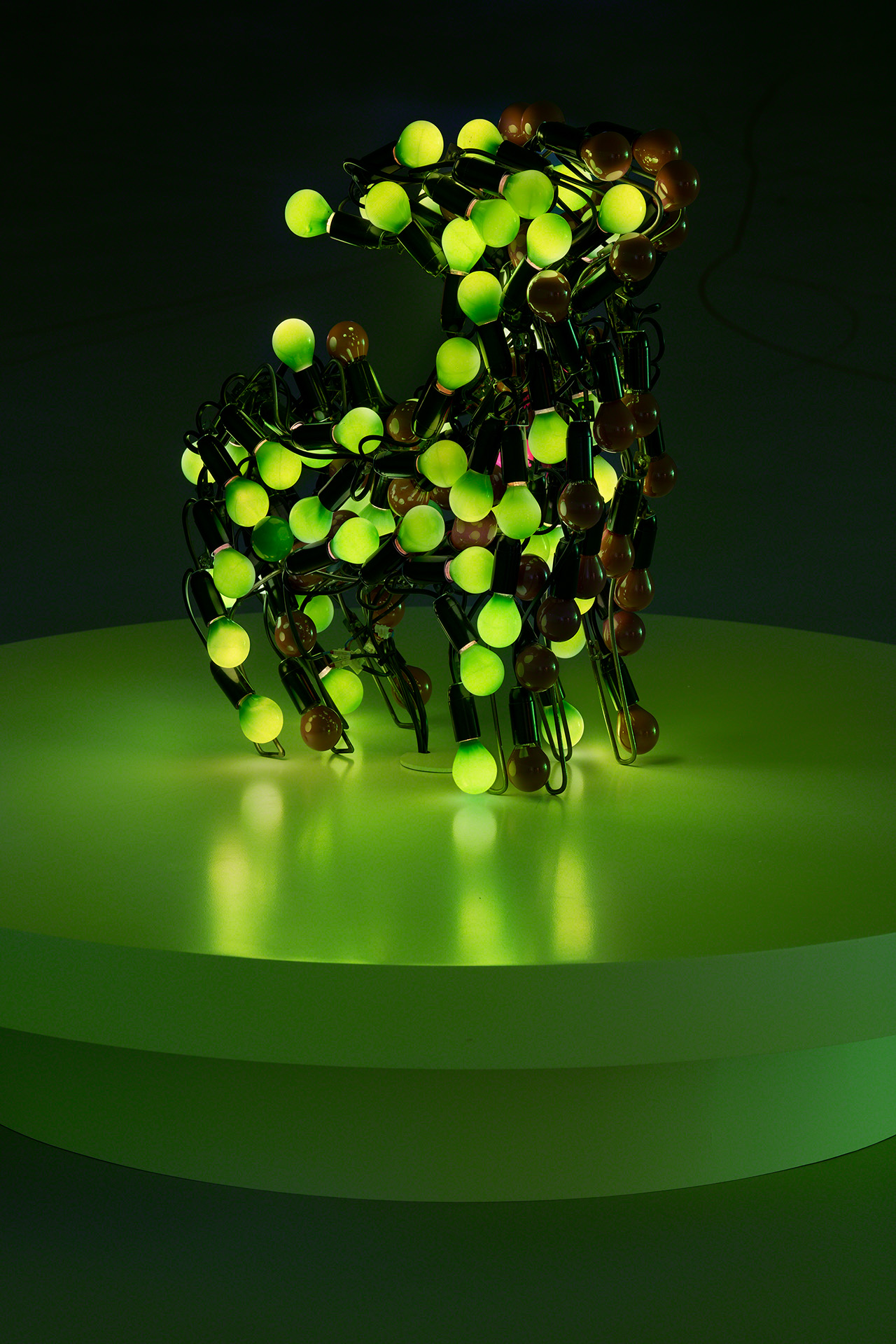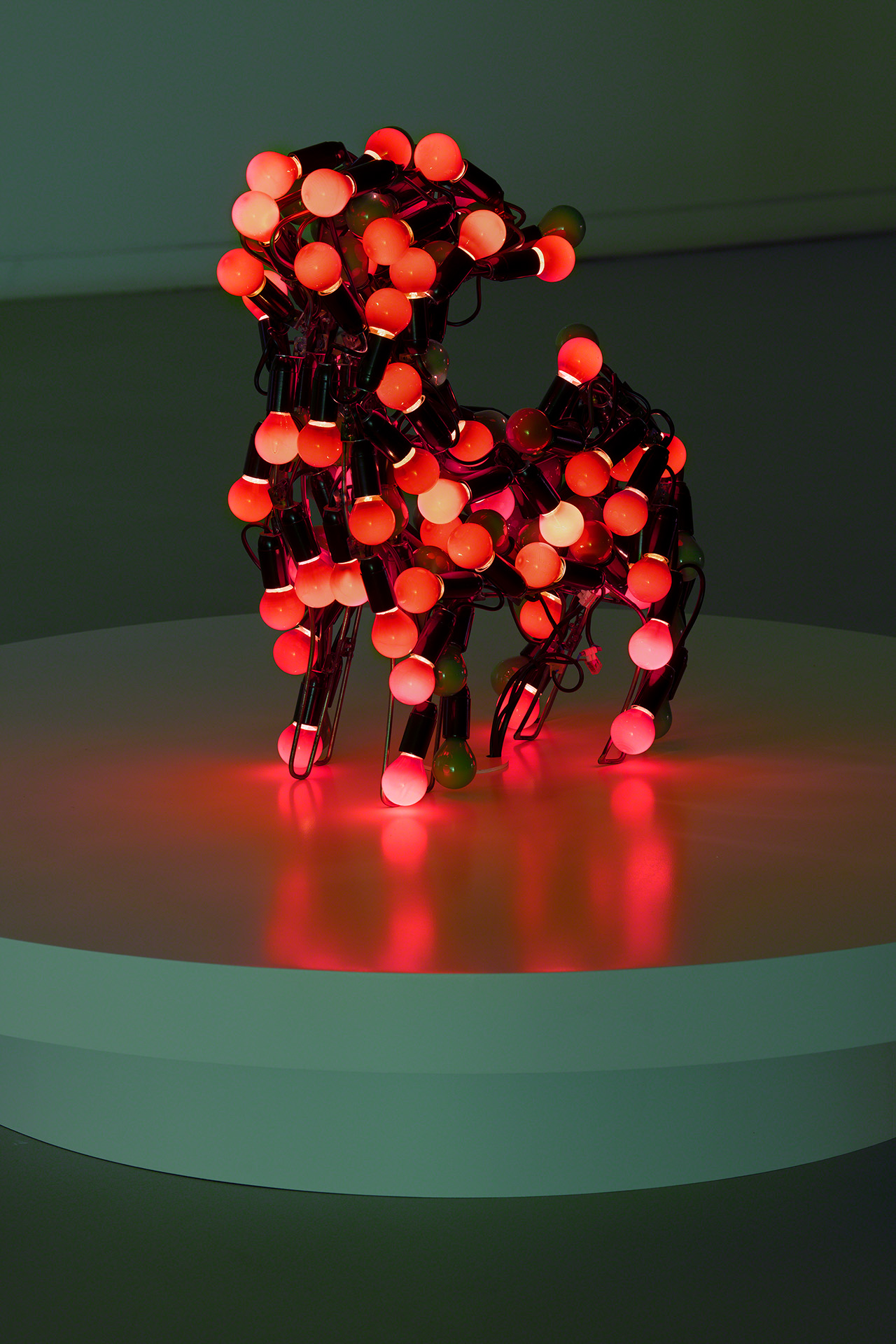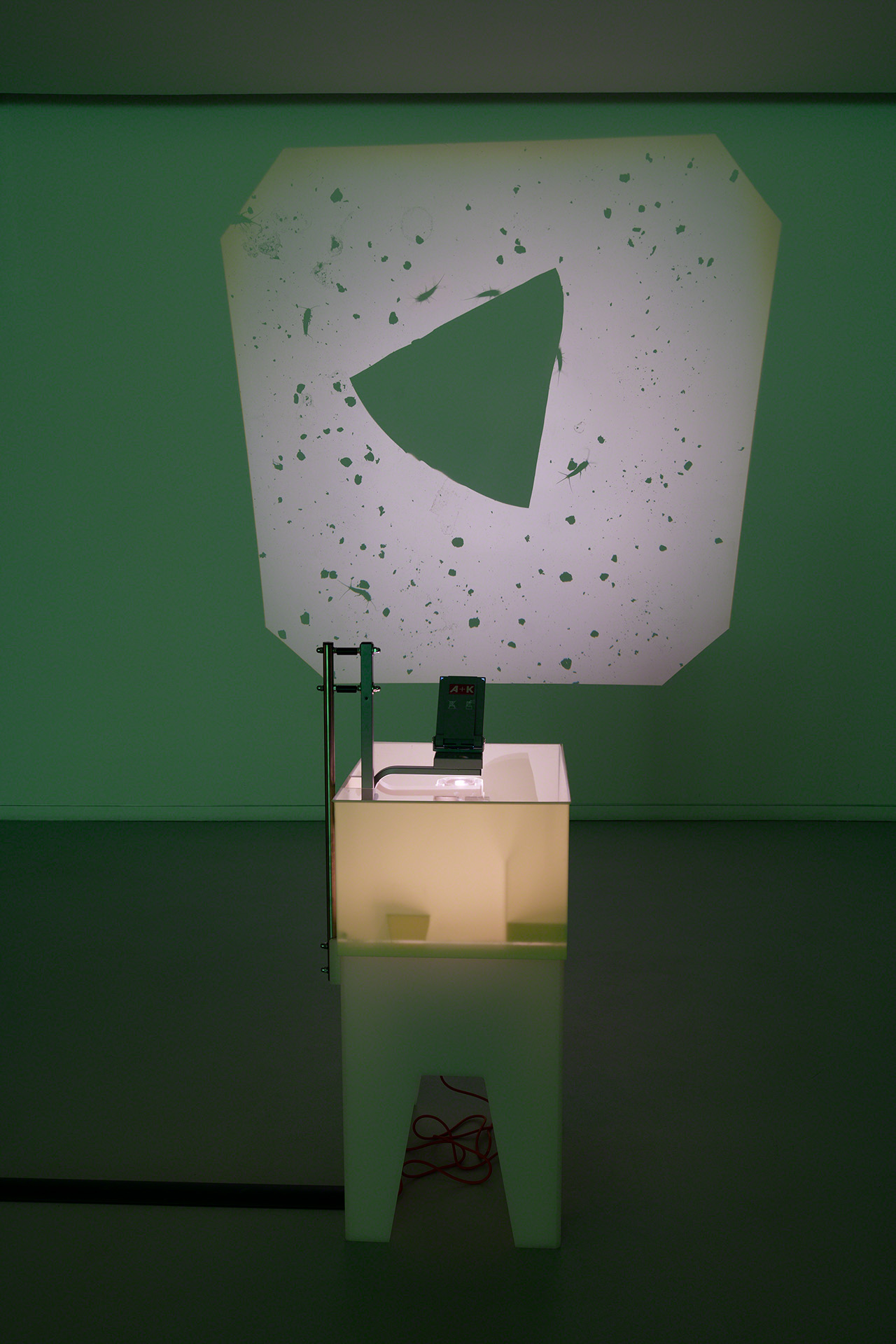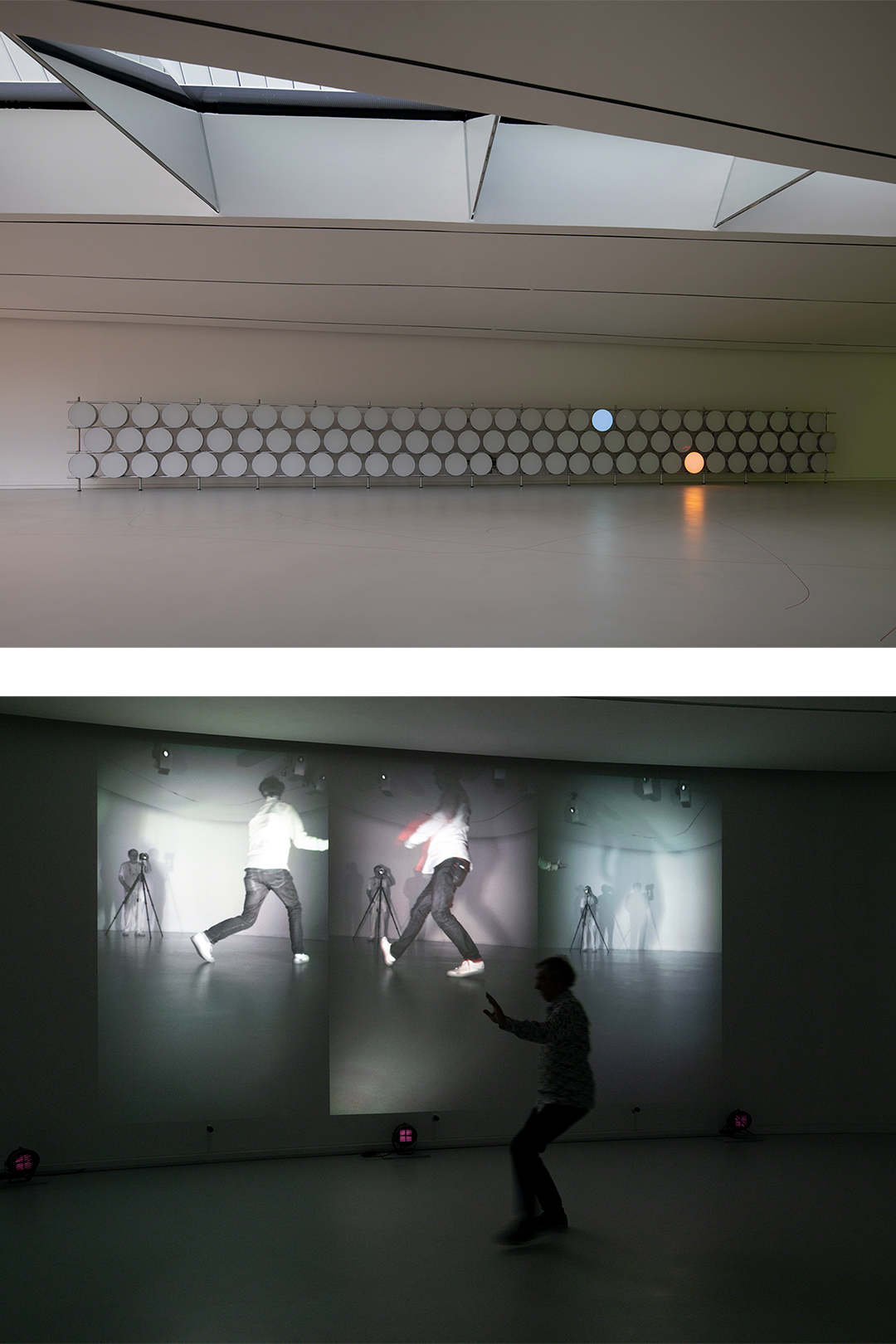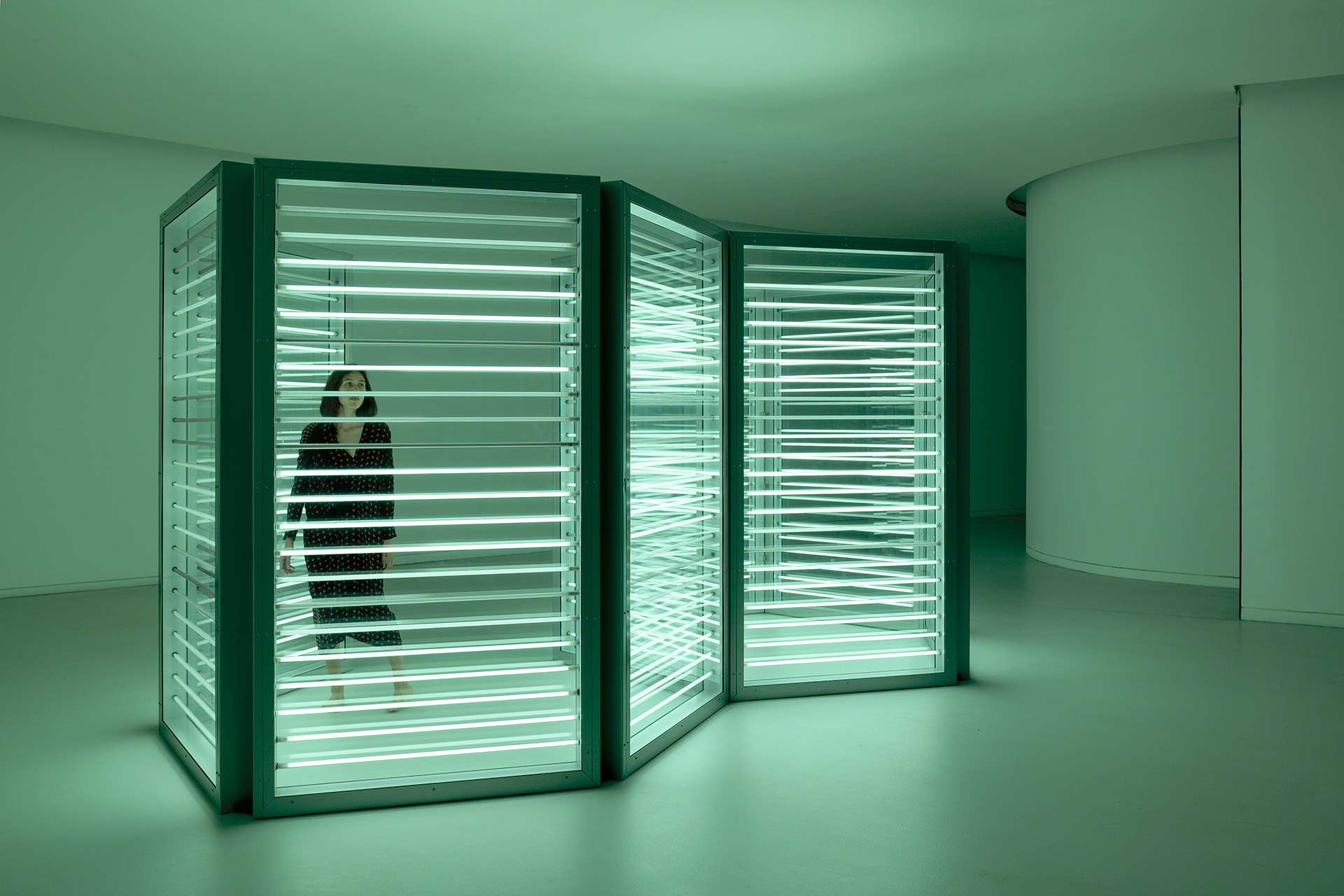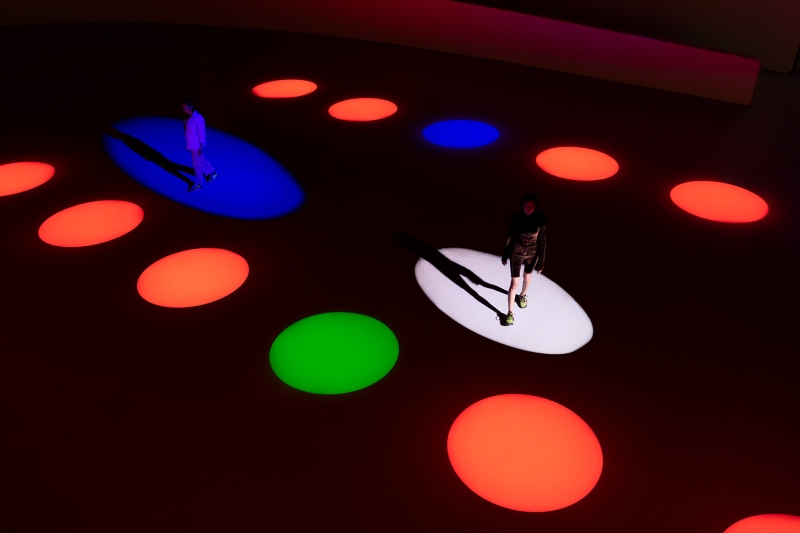Carsten Höller: DAY
The exhibition meanders around light and darkness through the nude belly of the building, creating a flow of energy that guides the public through a multiplicity of sensorial experiences.
— Vicente Todolí
Light Wall (Outdoor Version)
2021
Steel, LED bulbs, controller, sound generator, loudspeakers
3278 × 400 × 600 cm
Courtesy of the artist and MASSIMODECARLO.
Light Wall interacts with the predictability of the constancy of both natural and artificial light. It consists of a metal structure holding 1100 lightbulbs which are simultaneously blinking at a frequency of 7.8 Hz. This rhythm has visual (and auditory) hallucinatory effects on the viewer, as it presumably influences brainwave frequencies (there is a sound element too: a stereo click at the same frequency). Dreamlike “colour fields” appear to the visitor standing in front of Light Wall with closed eyes; the effect is weaker with open eyes but, because of the clicking sound, a sort of “something is wrong here” impression arises. One’s own thoughts, spoken words, and behaviour in general will be influenced by the flickering lights and clicking sounds, thus changing not only the perceived, but also its interpretation. In conversations with others, what they say seems “unreal “, while the self-uttered words may be felt as never really leaving one’s head. See also 7.8 (Reduced Reality App), 2021, 7.8 Hz (Vitrine with Golden Fly Agaric Mushrooms), 2019, and Light Corridor, 2016.
Moving Image
1994/2004
Colour slide, projector with perforated metal disc.
Dimensions variable.
Courtesy of the artist and [mac] musée d’art contemporain, Marseille.
Projection of a slide image onto maat’s entrance doors showing Muhammad Ali giving the final knockout hit to the supposedly invincible world heavyweight champion George Foreman in Kinshasa, 1974. The image is projected through a rotating, perforated disc which causes the impression that the boxer is “falling out of the image” in slow motion.
Lisbon Dots
2021
Spotlights, lasers, software
Dimensions variable
Courtesy of the artist
Lisbon Dots consists of 20 spotlights in four colours, which follow people’s movements and allow them to play a “reward and punishment” game with each other. Initially, there are 14 red, 3 blue, 2 green dots and 1 white dot. People having a red dot can “upgrade” to blue by overlapping their dot with a blue dot for a certain amount of time. The amount of overlap also plays a role. From blue, players can “upgrade” to green, and then to white – the respective blue, green and white dots lose their “status” and each get “downgraded” by one colour step. However, if all red dots unite by forming an uninterrupted chain or cluster, all 20 dots turn white. This situation will last until 7 or more white dots don’t overlap with the other white dots anymore: at this point, the game is over, and the colour dots revert to the initial constellation.
4
Choice Corridor
2000, ongoing
Drywall, wood
Dimensions variable
Courtesy of the artist.
A dark corridor winds back and forth in curves until the light from the entrance disappears completely. In darkness, visitors feel their way through the space by touching the walls, until they reach the light again entering from the other side. In the pitch-black middle section of the corridor, however, one doesn’t realise that the path is divided into two sections of equal length. If a visitor happens to be inside the corridor with others who, without knowing that there is a choice, take the other way, then they will “disappear” acoustically, or at least sound as if they are suddenly at a distance. A chair is placed in a cubicle in the middle of the corridor for those who want to hear the others feeling their way through. Choice Corridor can also be experienced by using our own phone’s torch as a light source, installing and opening the 7.8 (Reduced Reality App).
5
Half Clock (Novial Gold, Salmon Rose and Purple)
2021
Neon glass tubes, stainless steel, controllers, software
80 cm (diameter)
Courtesy of the artist.
Half Clock (Lime green, Turquoise and Pink)
2014
Neon glass tubes, stainless steel, controllers, software
80 cm (diameter)
Courtesy of the artist and Thyssen-Bornemisza Art Contemporary.
Both Half Clocks consist of three interlocking half spheres made of differently coloured neon-filled tubes. The outer part represents seconds, the central part minutes, and the inner part hours. However, as the name suggests, only half of the time is represented, i.e. the first 12 hours of a full day. In addition, only 30 minutes and 30 seconds of each hour are shown, irrespective of the hour. To make things even more complicated, the 60 units of an ordinary clock face are translated into 360 degrees, with their allocation following a logic of angular bisectors, wherein the largest undivided area that forms the lower, imaginary half of the sphere is 180°, the subsequent one 90°, then 45°, 22.5°, 11.25°, 5.625°, and finally 2.8125°. Transferred onto the face of an analogue clock, these bisectors function as hands, which are represented, and thus made visible, only at the seven fixed degree points. Whenever the time coincides with the position of one of the neon tubes, they will turn on, but only for the particular second, minute, or hour based on the equation. The second hand lights up for only one second, the minute hand for one minute, and the hour hand for one full hour. Thus, if the time is 9 hours 14 minutes and 15 seconds, all three half-spheres light up at the respective representative bisectors. If the time is 16 hours 20 minutes and 30 seconds, none of the three half-globes are lit. To make the representation of time so difficult to decipher is an attempt to deal with the complexity of the perception of time passing by.
Divisions Wall
2016
Neon glass tubes
Dimensions variable
Courtesy of the artist.
Divisions Wall is divided into sections, each of which contains exactly half of the number of neon tubes in the preceding sections (or twice as many, depending on which end the work is approached from). The tubes are illuminated green on one side and yellow on the other. Based on the mathematical concept of the asymptote, an equation according to which a curve tends to draw indefinitely closer to a line (or a number towards zero), but never actually reaches it, the work potentially divides into infinity.
Divisions (Turquoise Lines and Pink Circles)
2014
Neon glass tubes, acrylic glass
202 × 29 × 186 cm
Courtesy of the artist and Gagosian.
Divisions (Salmon Rose Lines and Novial Gold Circles)
2019
Neon glass tubes, acrylic glass
202 × 29 × 186 cm
Courtesy of the artist and Galleria Continua.
An arrangement of neon tubes following the mathematical division into equal surfaces. A large circle is divided into two halves by a vertical line. At the centre of the line, a second line with half the length departs horizontally, in an angle of 90°. The second line is again vertically divided in half, the third line is again horizontally divided, and so on — up to a total of seven lines. From the third division onwards, they do not represent exactly 50% length of the previous line anymore, but become shorter, due to the outline of the space defined by the large outer circle in which they are integrated. At the smallest division point of the lines, the centre of the second largest circle is placed, representing the percentage of the length of the line in relation to the largest line. The next, third largest circle has its centre at the following division of two lines, etc., forming seven circles in total. The smallest circle has its centre at the second division point of the lines, where the second and third lines meet. The density of the neon tubes also corresponds to the mathematical division principle, with the smallest circle being the brightest, and the largest circle the dimmest, and the opposite for the lines.
Decimal Clock (White and Pink)
2018
Neon glass tubes, aluminium, controllers, software
446 × 100 cm (diameter × depth)
Courtesy of the artist and Galleria Continua.
Decimal Clock is a functional clock based on the idea of counting time in decimal units, proposed during the French revolution. The 110 neon rings represent the time of a full day divided into 10 hours. Each decimal hour has 100 minutes and each minute has 100 seconds. Every 11th ring represents an hour, starting from the smallest innermost ring. Minutes are counted by consecutively switching on the 10 rings between the hours. Seconds are building up within rings by lightning up the 5 segments of each ring one after the other in a clockwise rotation.
Yellow/Orange Double Sphere
2016
Acrylic glass, brass, steel, light bulbs, controllers
220 cm (diameter)
Courtesy of the artist.
A ceiling-suspended double sphere containing blinking lightbulbs. The inner sphere fits tightly within the outer sphere and can be made to roll inside it (it is held in place by ball bearings). In theory, Yellow/Orange Double Sphere is a vehicle that could be used to roll down a hill with a person inside: the lights would then be powered by energy generated by a dynamo that rolls against the inside surface of the outer sphere. As a result of the large openings in the spheres and the transparency of the material, a variety of red tones would be seen through the double sphere, which, when in motion, would create a flicker alongside the blinking of the lights.
Light Corridor
2016
LED lights, steel, laminated glass, controllers
453 × 255 × 307 cm
Courtesy of the artist and INELCOM.
Light Corridor is composed of two luminous walls that blink on and off at a frequency of 7.8 Hz. At the top and the sides of the two walls, LED streetlights and bulbs also go on and off at the same frequency. See 7.8 (Reduced Reality App), 2021, Light Wall (Outdoor Version), 2021, and 7.8 Hz (Vitrine with Golden Fly Agaric Mushrooms), 2019.
7.8 Hz (Vitrine with Golden Fly Agaric Mushrooms)
2019
Gold-coated polyurethane mushroom casts, glass, steel, silk, LED bulbs, controller
127 × 65 × 198 cm
Courtesy of the artist.
The lights in the vitrine flicker at the hallucination-inducing frequency of 7.8 Hz, which makes the 10 golden fly agaric mushroom sculptures in the vitrine seem to “dance” and “rotate” around their own axis. Fly agarics have until recently been used as intoxicants in shamanistic rituals. See 7.8 (Reduced Reality App), 2021, Light Wall (Outdoor Version), 2021, and Light Corridor, 2016.
Bambi
2006
Lightbulbs, steel, controllers
70 × 30 × 70 cm
Courtesy of the artist.
Bent wire construction of two intertwined and offset, bent metal forms, each of which represents a Bambi. The corresponding red or green light bulbs blink in alternation, at a frequency causing the object to appear as if it’s constantly jumping back and forth between the two forms. The same frequency, causing a hallucination entitled “phi phenomenon” (also known as persistence of vision), is used in Phi Wall II, 2002.
Phi Wall II
2002
Neon glass tubes, acrylic glass, colour filters, aluminium, controllers
Dimensions variable
Courtesy of the artist.
A wall with “jumping lights”, based on the phi phenomenon (see Bambi, 2006). Two points of light are “jumping” at the same time. Both light points can “jump” in up to six different directions from the location of the last illuminated disc. However, the distance between two consecutively illuminating discs remains always the same. It is astonishing to realise that a viewer sees “jumping lights” with colour changes in the middle of the trajectory, since neither the direction nor the potential shifts in colour are predictable (the sequence is generated at random). How does one know beforehand where the next light will “jump” to, and which colour it will have?
Two Roaming Beds and Insensatus
2015
Painted steel, electric motors, 3D printed nylon, rubber tires, LED lamp, acrylic glass, phone chargers, mattresses, linen, ink, pens, toothpaste, toothbrush 2 parts,
210 × 100 × 130 cm (approx.) each
Courtesy of the artist and Christel Bonnier Collection.
These robotic twin beds roam the exhibition like a pair of restless, insomniac twins. Empty by day, by night they are occupied by guests who are transported around the gallery space as they dream. A red or blue pen traces the movements of the beds (and the sleepers) on the floor when they are occupied. With time, these lines add up to a gigantic drawing. An Insensatus kit is given to overnight guests as part of their stay in the exhibition, containing 4 tubes with toothpaste and a toothbrush. The largest tube contains an activator toothpaste which enhances one’s capacity to remember dreams. The smaller tubes contain three substances that evoke dreams related to the female, male and infantile world. Users can adjust the intensity and outcome of the desired dreams by combining the female, male and infantile toothpastes with the activator in different quantities.
Carsten Höller and Rigobert Nimi
Top Mode Africa
2013
Aluminium, metal foil, plastic, wood, paper, light bulbs
220 × 161 × 112,6 cm
Courtesy of the artists and Air de Paris, Romainville.
Top Mode Africa is the result of collaboration with the Congolese artist Rigobert Nimi. It consists of a rectangular model, structured around a dividing axis, at the centre of which a fashion runway is set, complete with cardboard cut-outs of mannequins. On each side of the catwalk, a symmetrical set-up of rows of seats facing the fashion show are arranged. Behind them, two carousel-like circular platforms raise from the ground, with a cake-like top ending in a light bulb. Close inspection reveals that the elaborate construct is built from simple and found materials, such as plastic screw tops from drinking bottles. This work is a model for the set design of the film Fara Fara (2014), a film realised as a double projection in collaboration with Måns Månsson.
Carsten Höller and Rosemarie Trockel
Silberfischchenhaus (Silverfish House)
1999
Overhead projector, acrylic glass, filter paper, sugar solution, live silverfish
62 × 54 × 150 cm
Courtesy of the artists.
A collaboration with Rosemarie Trockel, consisting of a container for silverfish on an old-style overhead projector. The shadows of the animals are projected onto the nearby wall at regular intervals as the projector lamp switches on and the silverfish run away from the light to seek cover.
Double Neon Elevator
2016
Steel, fluorescent tubes, glass, controllers.
Two parts, 440 × 240 × 360 cm each
Courtesy of the artist.
The neon tubes inside the seven vertical wall elements making up Double Neon Elevator are configured in such a way that the light appears to “move upward or downward.” This creates in the viewer standing inside the installation the sensation of going up or down in an elevator. Because of the transparency of the construction, not only does the Neon Elevator “go up or down”, but the entire surrounding room does as well.
Infrared Room
2006
Infrared cameras, infrared lamps, video projectors, software
Dimensions variable
Courtesy of the artist.
An attempt to dissociate the self from the linearity of time. At any given moment, one of the projections shows images of a person present in the space in real time, while the other two projections each show images at different rates of delay. The delays in the projected images change continuously and are dynamically looped, so that a projection showing images from the past becomes the current image in real time, while at the same time the projection that had just been showing live images is getting more and more delayed. Visitors identify with their images projected in real time up to the point where the delay becomes so great that the projection is no longer perceived as happening in the present; the viewer abandons identification with one projection for the next projection that appears to be seen in real time. The dissociative effects are enhanced by the images being taken from slightly different viewing angles between the three projections.
19
Untitled (Emergency Lights)
1987
2 emergency lights
38 × 19 cm each
Courtesy of the artist.
Carsten Höller’s first artwork using light.
Views of the exhibition “DAY” by Carsten Höller (maat, 05/10/2021–28/02/2022) by Attilio Maranzano. Courtesy of the artist and EDP Foundation / maat.
After earning a PhD in phytopathology with a specialisation in chemical ecology at Kiel University, Germany, from 1993 onwards Carsten Höller devoted himself exclusively to art. Höller applies his training as a scientist to his work as an artist, focusing particularly on the nature of human reasoning and interrelations. Notable installations include “Soma” (2010), a three-dimensional tableau vivant at Hamburger Bahnhof, in Berlin, with reindeer fed with fly agaric mushrooms; “Test Site” (2006), a series of giant slides installed in Tate Modern’s Turbine Hall; and “Upside-Down Goggles” (2009–11), an ongoing participatory experiment with vision distortion through goggles. For Höller, the museum can be seen as a space for experimentation and for testing ideas and concepts that can eventually be enacted on a larger scale. “Synchro System”, referring to the synchronisation between viewer and artwork, between human beings and “machine effects”, was conceived by Höller for Fondazione Prada, Milan (2000) and consisted in the realisation of a “village of possibility” composed of psychophysical stimuli and interactive tools. Other major solo exhibitions by Höller include “7,8 Hz”, Le Consortium, Dijon (2004); “Carrousel”, Kunsthaus Bregenz, Austria (2008); “Experience”, New Museum, New York (2011); “Doubt”, Pirelli HangarBicocca, Milan (2016); and “Sunday”, Museo Tamayo, Mexico City (2019).
Curated by Vicente Todolí, DAY (maat, 05/10/2021 – 28/02/2022) a monographic exhibition by Carsten Höller, unfolds across the entire building in an arranged parcours through installations, sculptures and projections that enter in dialogue with the unique spatial character of organic curvatures, narrowed thresholds and differently sized and lit volumes. Devoid of any support structure nor using any inbuilt lighting system, the museum is solely illuminated by the works themselves, leading audiences through a sequence of multi-sensorial experiences of altered perception. Extending outside-in, the exhibition features Lisbon Dots, presented here for the very first time. Installed in the large oval room in the centre of the museum, it’s an interactive installation made of 20 spotlight projectors that follow visitors’ movements and allow them to play a game with each other.


